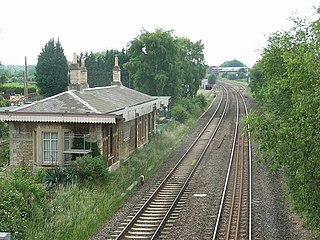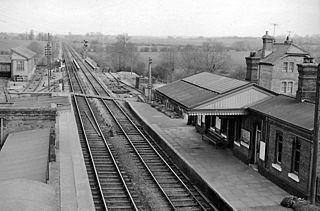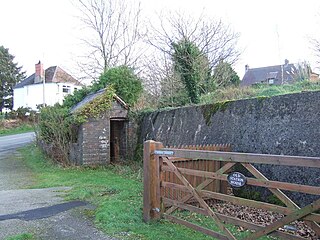
Kingham railway station in Oxfordshire, England, is between the Oxfordshire village of Kingham and the Gloucestershire village of Bledington, to which it is closer. It is also the closest station to the town of Chipping Norton.

Alvescot railway station was a railway station between the Oxfordshire villages of Alvescot and Black Bourton, in England. It was Oxford, Witney and Fairford Railway between Oxford and Fairford.

Aynho for Deddington railway station was a railway station serving the village of Aynho in Northamptonshire, England. It was on what is now known as the Cherwell Valley Line.
Yarnton Junction was a three-platform station serving the village of Yarnton, Oxfordshire. It was built in 1861 at the junction of the Oxford, Worcester and Wolverhampton Railway and Witney Railway, north of Oxford. British Railways closed the station to passengers in 1962 and it was demolished c. 1965.

Kelmscott and Langford railway station was a railway station south of the village of Langford on the Oxford, Witney and Fairford Railway, between Oxford and Fairford.

Lechlade railway station served the small town of Lechlade in Gloucestershire, England. The station was on the Oxford, Witney and Fairford Railway, between Oxford and Fairford, it was built where the line crossed the road to Burford, 0.5 miles (0.80 km) north of Lechlade.

Fairford railway station served the town of Fairford in Gloucestershire. It was the western terminus of the Oxford, Witney and Fairford Railway between Oxford and Fairford. It had one platform, and a stone-built station building.

Bletchington railway station is a disused station in Oxfordshire at Enslow, England, a hamlet 1.25 miles (2 km) west of the village of Bletchingdon. The station had a number of names during its period of operation: 'Woodstock', 'Woodstock Road', 'Kirtlington' and finally 'Bletchington'.

Haddenham railway station was on the former Great Western and Great Central Joint Railway between Princes Risborough and Ashendon Junction. It was closed in 1963.

Moulsford railway station was on the original route of the Great Western Railway, being one of three intermediate stations provided when the line was extended from Reading to Steventon in 1840.

Southam Road and Harbury railway station was a railway station, located 1 mile (1.6 km) east of Harbury, and 2.5 miles (4.0 km) south-west of Southam, Warwickshire.
Hinksey Halt railway station was built by the Great Western Railway to serve New Hinksey, a suburb of Oxford.
Tetbury Road railway station was built by the Cheltenham & Great Western Union Railway to serve the Gloucestershire villages of Kemble and Coates, and the town of Tetbury.

Savernake Low Level railway station was a station on the Berks and Hants Extension Railway, near the village of Burbage in Wiltshire, England. It was open from 1862 until 1966.
Sarnau railway station served the village of Bancyfelin, Carmarthenshire, Wales; it was close to the hamlet of Sarnau. It was on the West Wales Line.
Park Leaze Halt railway station was one of two intermediate halts on the Cirencester branch line from Kemble, Gloucestershire, England. It was one of the shortest-lived stations in post-World War II Britain, being open for just over four years, between 1960 and 1964.
The Clarbeston Road and Letterston Railway was a small railway company formed to give the Great Western Railway a more direct route to the port at Fishguard Harbour.

Wolf's Castle Halt railway station was on the Clarbeston Road and Letterston line of the Great Western Railway. It served the villages of Wolf's Castle and Ford between 1913 and 1964.

Dinmore railway station served the villages of Bodenham and Hope under Dinmore, Herefordshire, England between 1853 and 1958.

Mathry Road Halt railway station was on the Clarbeston Road and Letterston line of the Great Western Railway. It served the village of Letterston 1 mile to the south east, and on railway maps was suffixed for St David's. It was named Mathry when opened in 1923, and renamed the following year.














